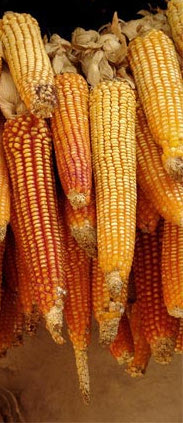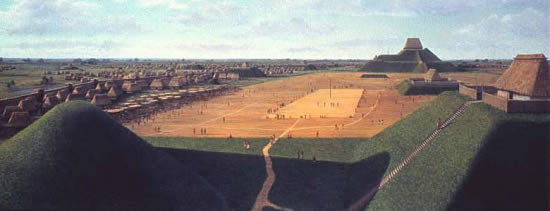
Cahokia: A cautionary tale
Cahokia was an
ill-fated, American Indian settlement near present-day St. Louis.
When the city was settled around 1,000 A.D., Indian
populations had grown to such a level in the eastern United States that
game was becoming scarce. Luckily, maize (corn) was making its
way north from Central and South America, allowing the Indians to
replace their hunting lifestyle with a more agricultural one.
 One visionary leader realized that
changing to a lifestyle centered
around maize would require building granaries to store the kernels over
the winter. He figured the best way to go about it would be to
create a huge communal granary so that the combined might of the
community could protect the maize from depradations by neighboring
groups. Some 15,000 people joined this unnamed leader in his
quest to construct a giant city --- the largest north of the Rio Grande
--- and to plant vast fields of maize.
One visionary leader realized that
changing to a lifestyle centered
around maize would require building granaries to store the kernels over
the winter. He figured the best way to go about it would be to
create a huge communal granary so that the combined might of the
community could protect the maize from depradations by neighboring
groups. Some 15,000 people joined this unnamed leader in his
quest to construct a giant city --- the largest north of the Rio Grande
--- and to plant vast fields of maize.
Unfortunately, the population of Cahokia grew so large that the water
from the stream flowing by the city couldn't support the city's
people. So the Cahokians channeled a nearby stream from its
normal path, rerouting the water to join their existing stream and
turning their water supply into a river. More water! More
maize! More people!
The Cahokians continued to clear the surrounding land, cutting down
trees as building material, for fires, and to open up land to grow more
maize. Eventually, disaster struck. Heavy storms which
would have been soaked up by forest quickly ran off the agricultural
fields, bloating the river, and causing floods and mudslides in the
city of Cahokia. A subsequent earthquake was the last straw which
broke Cahokia's back. Within a few hundred years of its
inception, the city had
dissolved back into the earth.
The story sounds astoundingly familiar. Clearcutting, stream
channelization, monoculture, and overpopulation leading to flooding and
ecological
collapse --- it could be set next door to my house. The end of
the story, though, is something I only see dimly in modern
agriculture's future. The Indians fled the city and developed a
more sustainable agricultural system based on small fields of maize
surrounded by managed forests of fruit and nuts. Maybe those
Noble Savages were pretty smart after all.
| This post is part of our American Indian Permaculture lunchtime
series.
Read all of the entries: |
Want more in-depth information? Browse through our books.
Or explore more posts by date or by subject.
About us: Anna Hess and Mark Hamilton spent over a decade living self-sufficiently in the mountains of Virginia before moving north to start over from scratch in the foothills of Ohio. They've experimented with permaculture, no-till gardening, trailersteading, home-based microbusinesses and much more, writing about their adventures in both blogs and books.
Want to be notified when new comments are posted on this page? Click on the RSS button after you add a comment to subscribe to the comment feed, or simply check the box beside "email replies to me" while writing your comment.

